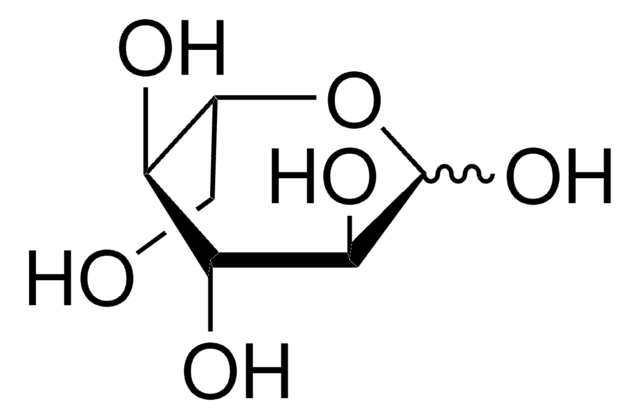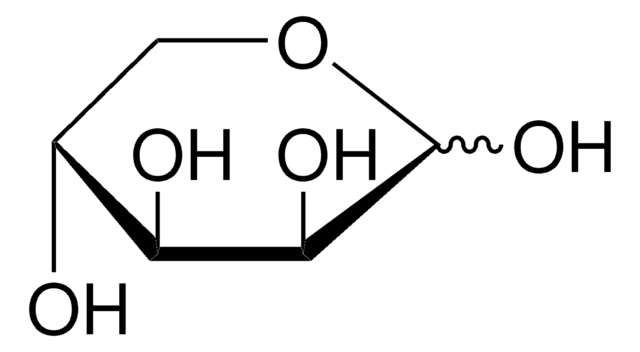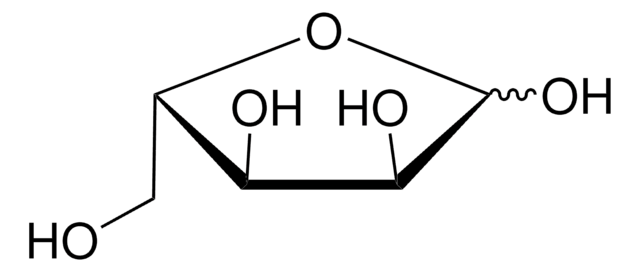All Photos(1)
About This Item
Empirical Formula (Hill Notation):
C6H12O6
CAS Number:
Molecular Weight:
180.16
Beilstein:
1724622
EC Number:
MDL number:
UNSPSC Code:
12352201
PubChem Substance ID:
NACRES:
NA.25
Recommended Products
Quality Level
Assay
≥99% (HPLC)
form
powder
technique(s)
HPLC: suitable
color
white
solubility
water: 50 mg/mL, clear, colorless
SMILES string
OC[C@@H]1OC(O)[C@@H](O)[C@H](O)[C@@H]1O
InChI
1S/C6H12O6/c7-1-2-3(8)4(9)5(10)6(11)12-2/h2-11H,1H2/t2-,3+,4+,5-,6?/m0/s1
InChI key
WQZGKKKJIJFFOK-DHVFOXMCSA-N
Looking for similar products? Visit Product Comparison Guide
Biochem/physiol Actions
L-Galactose was shown to be a key intermediate in the molecular pathway of converting D-glucose to oxalic acid in Pistia stratiotes.
Other Notes
To gain a comprehensive understanding of our extensive range of Monosaccharides for your research, we encourage you to visit our Carbohydrates Category page.
Storage Class Code
11 - Combustible Solids
WGK
WGK 3
Flash Point(F)
Not applicable
Flash Point(C)
Not applicable
Personal Protective Equipment
dust mask type N95 (US), Eyeshields, Gloves
Choose from one of the most recent versions:
Already Own This Product?
Find documentation for the products that you have recently purchased in the Document Library.
Customers Also Viewed
Minoru Tomizawa et al.
Oncology letters, 14(1), 899-902 (2017-07-12)
Tissues surrounding hepatocellular carcinomas (HCCs) lack glucose. Hepatocyte selection medium (HSM) is deficient in glucose and is supplemented with galactose. HCC cells were cultured in HSM to investigate the stem cell markers α-fetoprotein (AFP) and cluster of differentiation 44 (CD44).
Patrick Hossler et al.
mAbs, 9(4), 715-734 (2017-04-05)
Protein glycosylation is arguably the paramount post-translational modification on recombinant glycoproteins, and highly cited in the literature for affecting the physiochemical properties and the efficacy of recombinant glycoprotein therapeutics. Glycosylation of human immunoglobulins follows a reasonably well-understood metabolic pathway, which
S E Keates et al.
Phytochemistry, 53(4), 433-440 (2000-03-24)
Axenic Pistia stratiotes L. plants were pulse-chase labeled with [14C]oxalic acid, L[1-14C]ascorbic acid, L-6-14C]ascorbic acid, D-[1-14C]erythorbic acid, L-[1-14C]galactose, or [1-14C]glycolate. Specific radioactivities of L-ascorbic acid (AsA), free oxalic acid (OxA) and calcium oxalate (CaOx) in labeled plants were compared. Samples
Mili Thakur et al.
Scientific reports, 7(1), 231-231 (2017-03-24)
Premature ovarian insufficiency (POI) is a frequent long-term complication of classic galactosemia. The majority of women with this disorder develop POI, however rare spontaneous pregnancies have been reported. Here, we evaluate the effect of D-galactose and its metabolites, galactitol and
Dimitri Daudu et al.
Frontiers in plant science, 8, 1614-1614 (2017-10-06)
Cytokinin signaling is a key regulatory pathway of many aspects in plant development and environmental stresses. Herein, we initiated the identification and functional characterization of the five CHASE-containing histidine kinases (CHK) in the economically important
Our team of scientists has experience in all areas of research including Life Science, Material Science, Chemical Synthesis, Chromatography, Analytical and many others.
Contact Technical Service








